Geopolymeric Composites Containing Industrial Waste Reinforced with Arundo donax Fibers
Abstract
:1. Introduction
2. Materials and Experimental Procedures
2.1. Materials
2.1.1. Wastes
2.1.2. Binder
2.1.3. Aggregates
2.1.4. Fibers
2.1.5. Activators
2.2. Mix Design and Sample Preparation
2.3. Methods
2.3.1. Consistency
2.3.2. Physical Characterizations
2.3.3. Mechanical Characterizations
2.3.4. X-ray Diffraction Analysis
2.3.5. Mercury Intrusion Porosimetry
2.3.6. Microstructural Analysis
2.3.7. Water Absorption
2.3.8. Dimensional Stability
3. Results and Discussion
4. Conclusions
- -
- A room temperature curing process was selected, a condition that does not promote the waste dissolution but on the contrary, would enable on-site application of the materials. Moreover, since the reactive fraction of the different wastes is unknown, the same activator amount and ratio was considered for the modified mortars, thus unavoidably leading to an unbalanced ratio among the different oxides (Na2O/SiO2 and Al2O3/SiO2 ratios).
- -
- X-ray analysis performed on the cured mortars, however, did not show the presence of unreacted activators. Therefore, it can be supposed that the presence of the waste alters the final composition of the reacted gels leading to less developed networks but it does not hinder their formation.
- -
- At the investigated fraction, only a slight detrimental effect was recorded on the compressive strength that remained above 25 MPa, which would allow its use in structural repairs.
- -
- A slight reduction in consistency was also recorded but the value still enabled us to cast specimens without macroscopical porosities as revealed from the density measurements and morphological investigations.
- -
- LP, on account of the lower dimensions and higher amorphous character, provides higher mechanical properties hinting at a limited but effective reactivity. This is also reflected by the decrease in porosity derived by MIP as well as the decrease in water absorption by the capillary action of the mortar when compared to the GP-modified sample.
- -
- The addition of Arundo managed to increase the flexural strength and the dimensional stability of the mortars, slightly affecting the compressive strength.
- -
- A positive effect from the use of natural fibers was also found in the rate of water absorption.
Author Contributions
Funding
Data Availability Statement
Acknowledgments
Conflicts of Interest
References
- Supriya; Chaudhury, R.; Sharma, U.; Thapliyal, P.C.; Singh, L.P. Low-CO2 emission strategies to achieve net zero target in cement sector. J. Clean. Prod. 2023, 417, 137466. [Google Scholar] [CrossRef]
- Antunes, M.; Santos, R.L.; Pereira, J.; Rocha, P.; Horta, R.B.; Colaço, R. Alternative clinker technologies for reducing carbon emissions in cement industry: A critical review. Materials 2022, 15, 209. [Google Scholar] [CrossRef] [PubMed]
- Juenger, M.C.G.; Snellings, R.; Bernal, S.A. Supplementary cementitious materials: New sources, characterization, and performance insights. Cem. Concr. Res. 2019, 122, 257–273. [Google Scholar] [CrossRef]
- Cuesta, A.; Ayuela, A.; Aranda, M.A.G. Belite cements and their activation. Cem. Concr. Res. 2021, 140, 106319. [Google Scholar] [CrossRef]
- Miller, S.A. Supplementary cementitious materials to mitigate greenhouse gas emissions from concrete: Can there be too much of a good thing? J. Clean. Prod. 2018, 178, 587–598. [Google Scholar] [CrossRef]
- Sofi, M.; van Deventer, J.S.J.; Mendis, P.A.; Lukey, G.C. Engineering properties of inorganic polymer concretes (IPCs). Cem. Concr. Res. 2007, 37, 251–257. [Google Scholar] [CrossRef]
- Abulencia, A.B.; Villoria, M.B.D.; Libre, R.G.D.; Quiatchon, P.R.J.; Dollente, I.J.R.; Guades, E.J.; Promentilla, M.A.B.; Garciano, L.E.O.; Ongpeng, J.M.C. Geopolymers as sustainable material for strengthening and restoring unreinforced masonry structures: A review. Buildings 2021, 11, 532. [Google Scholar] [CrossRef]
- Tahwia, A.M.; Abd Ellatief, M.; Heneigel, A.M.; Abd Elrahman, M. Characteristics of eco-friendly ultra-high-performance geopolymer concrete incorporating waste materials. Ceram. Int. 2022, 48, 19662–19674. [Google Scholar] [CrossRef]
- Provis, J.L.; Palomo, A.; Shi, C. Advances in understanding alkali-activated materials. Cem. Concr. Res. 2015, 78, 110–115. [Google Scholar] [CrossRef]
- Gu, F.; Xie, J.; Vuye, C.; Wu, Y.; Zhang, J. Synthesis of geopolymer using alkaline activation of building-related construction and demolition wastes. J. Clean. Prod. 2023, 420, 138335. [Google Scholar] [CrossRef]
- Epure, C.; Munteanu, C.; Istrate, B.; Harja, M.; Buium, F. Applications of recycled and crushed glass (RCG) as a substitute for natural materials in various fields—A Review. Materials 2023, 16, 5957. [Google Scholar] [CrossRef] [PubMed]
- Amaludin, A.E.; Asrah, H.; Mohamad, H.M.; bin Amaludin, H.Z.; bin Amaludin, N.A. Physicochemical and microstructural characterization of klias peat, lumadan pofa, and GGBFS for geopolymer based soil stabilization. HighTech Innov. J. 2023, 4, 327–348. [Google Scholar] [CrossRef]
- ARPAE. Available online: https://www.arpae.it/ (accessed on 13 December 2023).
- Farhan, K.Z.; Johari, M.A.M.; Demirboga, R. Impact of fiber reinforcements on properties of geopolymer composites: A review. J. Build. Eng. 2021, 44, 102628. [Google Scholar] [CrossRef]
- Abbas, A.G.N.; Aziz, F.N.A.A.; Abdan, K.; Nasir, N.A.M.; Huseien, G.F. A state-of-the-art review on fibre-reinforced geopolymer composites. Constr. Build. Mater. 2022, 330, 127187. [Google Scholar] [CrossRef]
- Ranjbar, N.; Zhang, M. Fiber-reiforced geopolymer composites: A review. Cem. Concr. Comp. 2020, 107, 103498. [Google Scholar] [CrossRef]
- Zuaiter, M.; El-Hassan, H.; El-Maaddawy, T.; El-Ariss, B. Properties of Slag-Fly Ash Blended Geopolymer Concrete Reinforced with Hybrid Glass Fibers. Buildings 2020, 12, 1114. [Google Scholar] [CrossRef]
- Zhang, Z.; Zou, P.; Wang, Y.; Zhang, X. Impact of Nano-CaCO3 and PVA fiber on properties of fresh and hardened geopolymer mortar. Buildings 2023, 13, 1380. [Google Scholar] [CrossRef]
- Ramesh, V.A.; Jarghouyeh, E.N.; Alraeeini, A.S.; Al-Fakih, A. Optimisation investigation and bond-slip behaviour of high strength pva-engineered geopolymer composite (egc) cured in ambient temperatures. Buildings 2023, 13, 3020. [Google Scholar] [CrossRef]
- Korniejenko, K.; Łach, M.; Mikuła, J. The influence of short coir, glass and carbon fibers on the properties of composites with geopolymer matrix. Materials 2021, 14, 4599. [Google Scholar] [CrossRef]
- Silva, G.; Kim, S.; Aguilar, R.; Nakamatsu, J. Natural fibers as reinforcement additives for geopolymers—A review of potential eco-friendly applications to the construction industry. Sustain. Mater. Technol. 2020, 23, e00132. [Google Scholar] [CrossRef]
- Saccani, A.; Molari, L.; Totaro, G.; Manzi, S. Geopolymers reinforced with natural fibers: A comparison among different sources. Appl. Sci. 2021, 11, 11026. [Google Scholar] [CrossRef]
- Wongsa, A.; Kunthawatwong, R.; Naenudon, S.; Sata, V.; Chindaprasirt, P. Natural fiber reinforced high calcium fly ash geopolymer mortar. Constr. Build. Mater. 2020, 241, 118143. [Google Scholar] [CrossRef]
- Manzi, S.; Molari, L.; Totaro, G.; Saccani, A. Alkali-Activated Mortars Reinforced with Arundo donax: Properties and Durability to Environmental Stresses. Materials 2023, 16, 3898. [Google Scholar] [CrossRef] [PubMed]
- Moujoud, Z.; Sair, S.; Ousaleh, H.A.; Ayouch, I.; Bouari, A.E.; Tanane, O. Geopolymer composites reinforced with natural Fibers: A review of recent advances in processing and properties. Constr. Build. Mater. 2023, 388, 131666. [Google Scholar] [CrossRef]
- Aperador, W.; Bautista-Ruiz, J.; Sánchez-Molina, J. Geopolymers based on a mixture of steel slag and fly ash, activated with rice husks and reinforced with Guadua angustifolia fibers. Sustainability 2023, 15, 12404. [Google Scholar] [CrossRef]
- Vailati, M.; Mercuri, M.; Angiolilli, M.; Gregori, A. Natural-fibrous lime-based mortar for the rapid retrofitting of heritage masonry buildings. Fibers 2021, 9, 68. [Google Scholar] [CrossRef]
- Angiolilli, M.; Gregori, A.; Cattari, S. Performance of fiber reinforced mortar coating for irregular stone masonry: Experimental and analytical investigations. Constr. Build. Mater. 2021, 294, 123508. [Google Scholar] [CrossRef]
- Haily, E.; Zari, N.; Bouhfid, R.; Qaiss, A. Natural fibers as an alternative to synthetic fibers in the reinforcement of phosphate sludge-based geopolymer mortar. J. Build. Eng. 2023, 67, 105947. [Google Scholar] [CrossRef]
- Zhang, D.; Wang, Y.; Zhang, T.; Yang, Q. Engineering and microstructural properties of carbon-fiber-reinforced fly-ash-based geopolymer composites. J. Build. Eng. 2023, 79, 107883. [Google Scholar] [CrossRef]
- Manzi, S.; Lancellotti, I.; Masi, G.; Saccani, A. Alkali-Activated binders from waste incinerator bottom ashes and metakaolin reinforced by recycled carbon fiber composites. Front. Mater. 2020, 7, 583. [Google Scholar] [CrossRef]
- Sá Ribeiro, R.A.; Sá Ribeiro, M.G.; Sankar, K.; Kriven, W.M. Geopolymer-bamboo composite—A novel sustainable construction material. Constr. Build. Mater. 2016, 123, 501–507. [Google Scholar] [CrossRef]
- Libre, R.G.D., Jr.; Leaño, J.L., Jr.; Lopez, L.F.; Cacanando, C.J.D.; Promentilla, M.A.B.; Maximino, J.; Ongpeng, C. Microstructure and mechanical performance of bamboo fiber reinforced mill-scale—Fly-ash based geopolymer mortars. Clean. Chem. Eng. 2023, 6, 100110. [Google Scholar] [CrossRef]
- Suarez, L.; Barczewski, M.; Kosmela, P.; Marrero, M.D.; Ortega, Z. Giant Reed (Arundo donax L.) fiber extraction and characterization for its use in polymer composites. J. Nat. Fibers 2023, 20, 2131687. [Google Scholar] [CrossRef]
- Molari, L.; Coppolino, F.S.; García, J.J. Arundo donax: A widespread plant with great potential as sustainable structural material. Constr. Build. Mater. 2021, 268, 121143. [Google Scholar] [CrossRef]
- Manniello, C.; Cillis, G.; Statuto, D.; Di Pasquale, A.; Picuno, P. Concrete blocks reinforced with Arundo donax natural fibers with different aspect ratios for application in bioarchitecture. Appl. Sci. 2022, 12, 2167. [Google Scholar] [CrossRef]
- Ferrandez-García, A.A.; Ortuño, T.G.; Ferrandez-Villena, M.; Ferrandez-Garcia, A.; Ferrandez-García, M.T. Evaluation of particleboards made from giant reed (Arundo donax L.) bonded with cement and potato starch. Polymers 2022, 14, 111. [Google Scholar] [CrossRef]
- Ortega, Z.; Romero, F.; Paz, R.; Suarez, L.; Benítez, A.N.; Marrero, M.D. Valorization of invasive plants from macaronesia as filler materials in the production of natural fiber composites by rotational molding. Polymers 2021, 13, 2220. [Google Scholar] [CrossRef]
- Fiore, V.; Scalici, T.; Valenza, A. Characterization of a new natural fiber from Arundo donax L. as potential reinforcement of polymer composites. Carbohydr. Polym. 2014, 106, 77–83. [Google Scholar] [CrossRef] [PubMed]
- EN 196-1; Methods of Testing Cement—Part 1: Determination of Strength. European Committee for Standardization: Brussels, Belgium, 2016.
- Deshpande, A.P.; Rao, M.B.; Rao, C.L. Extraction of bamboo fibers and their use as reinforcement in polymeric composites. J. Appl. Polym. Sci. 2000, 76, 83–92. [Google Scholar] [CrossRef]
- EN 1015-3; Determination of Consistency of Fresh Mortars by Flow Table. European Committee for Standardization: Brussels, Belgium, 2007.
- EN 772-13; Determination of Net and Gross Dry Density. European Committee for Standardization: Brussels, Belgium, 2002.
- EN 15801; Conservation of Cultural Property—Test Methods—Determination of Water Absorption by Capillarity. European Committee for Standardization: Brussels, Belgium, 2009.
- ASTM C1012/C1012M; Standard Test Method for Length Change of Hydraulic-Cement Mortars Exposed to a Sulfate Solution. ASTM International: West Conshohocken, PA, USA, 2018.
- Guo, C.; Li, M.; Wang, S.; Zhang, S.; Li, Y.; Li, C. Alkali treatment of bamboo fibers improves the mechanical properties of me-takaolin geopolymer. J. Dispers. Sci. Technol. 2023, 45, 980–989. [Google Scholar] [CrossRef]
- España, J.M.; Samper, M.D.; Fages, E.; Sánchez-Nácher, L.; Balart, R. Investigation of the effect of different silane coupling agents on mechanical performance of basalt fiber composite laminates with biobased epoxy matrices. Polym. Compos. 2013, 34, 376–381. [Google Scholar] [CrossRef]
- Sabarinathan, P.; Rajkumar, K.; Annamalai, V.E.; Vishal, K. Characterization on chemical and mechanical properties of silane treated fish tail palm fibres. Int. J. Biol. Macromol. 2020, 163, 2457–2464. [Google Scholar] [CrossRef] [PubMed]
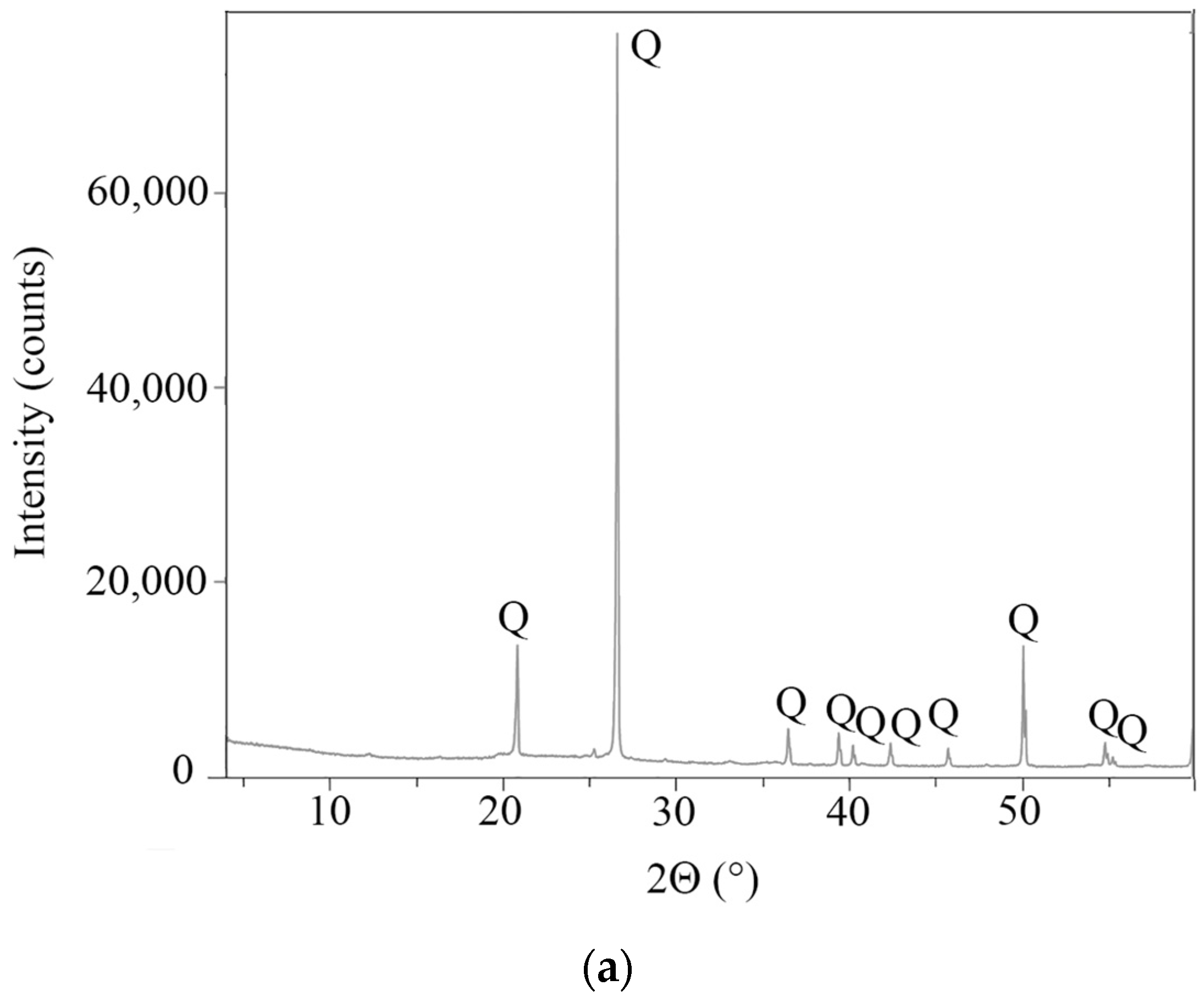

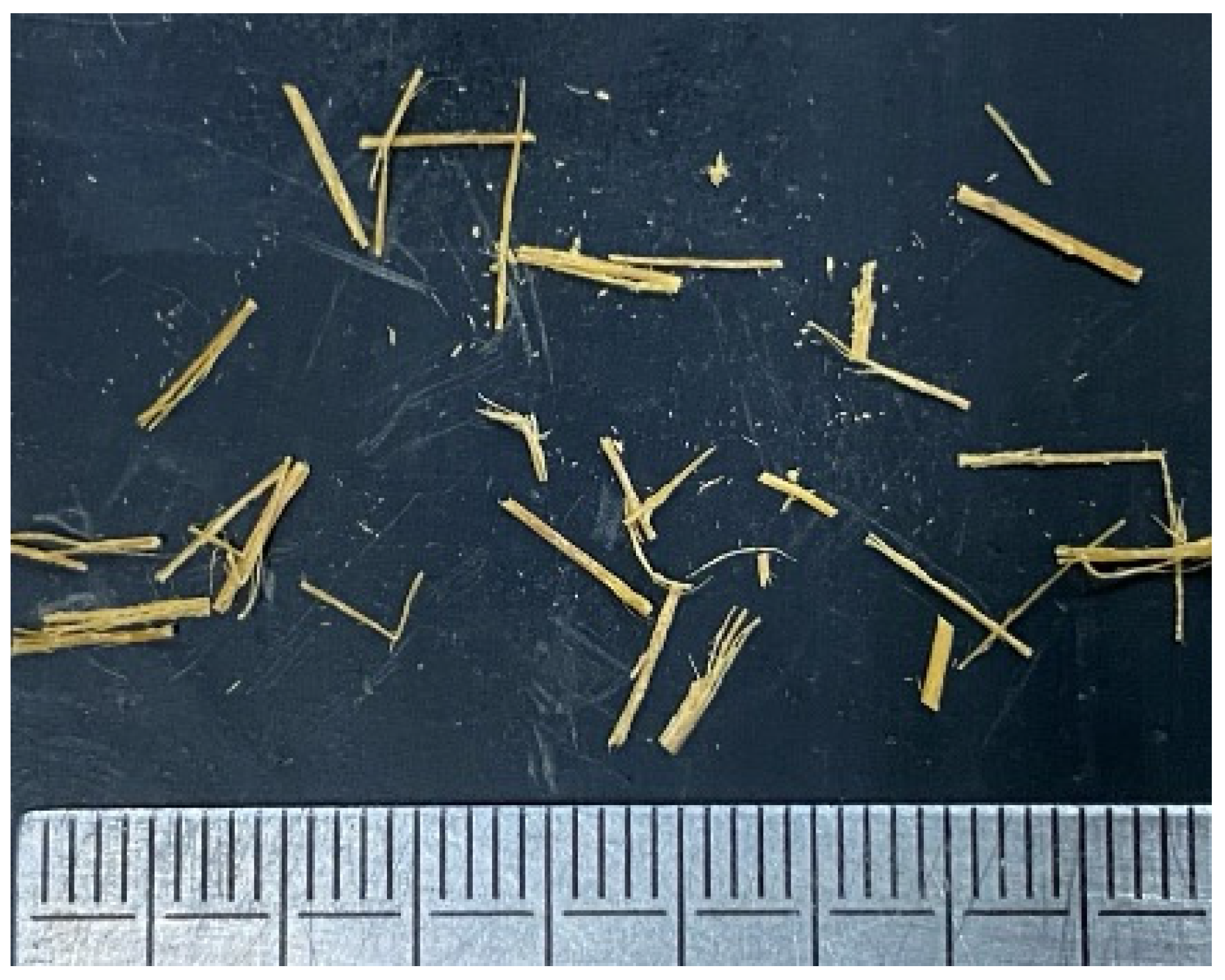

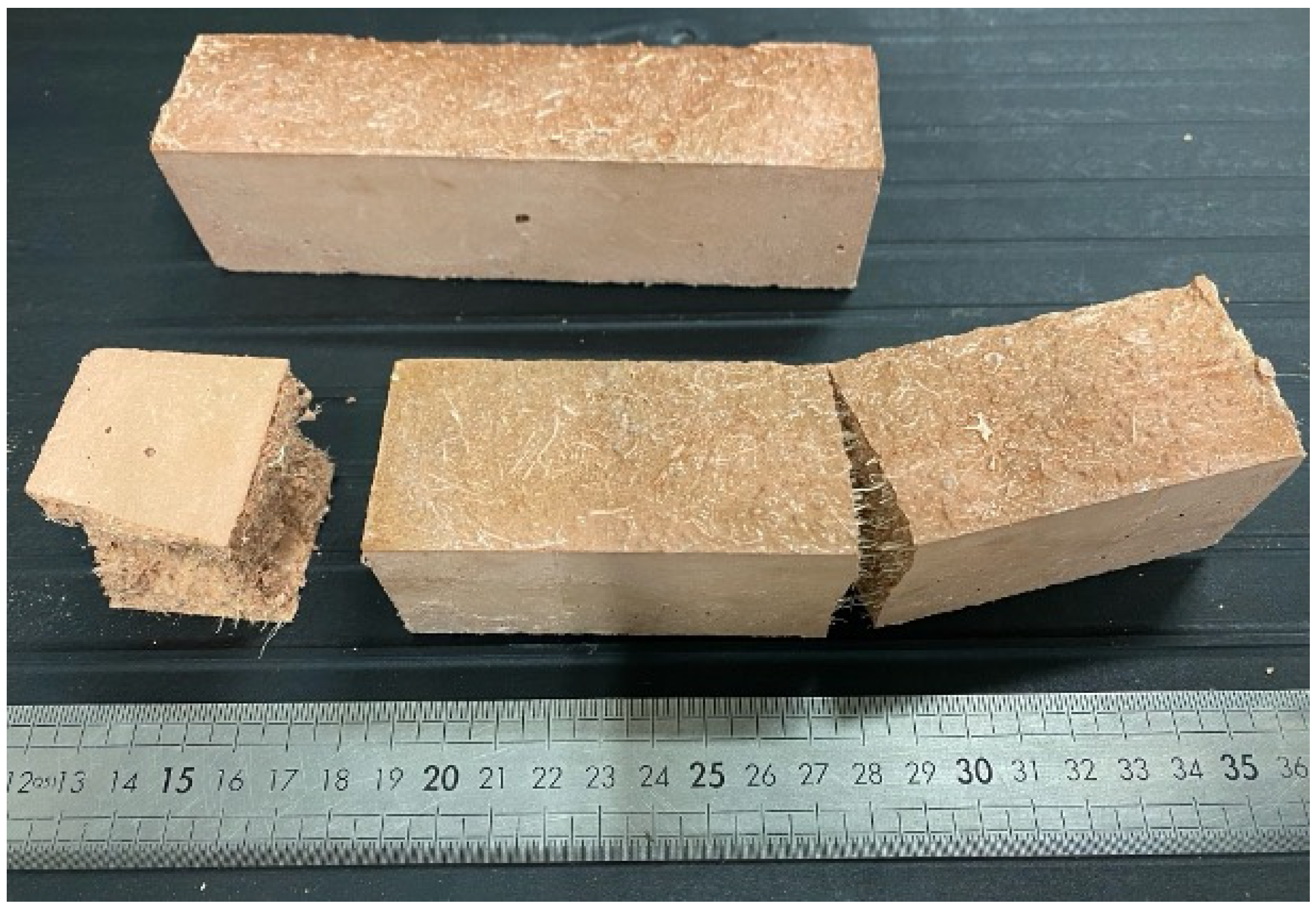
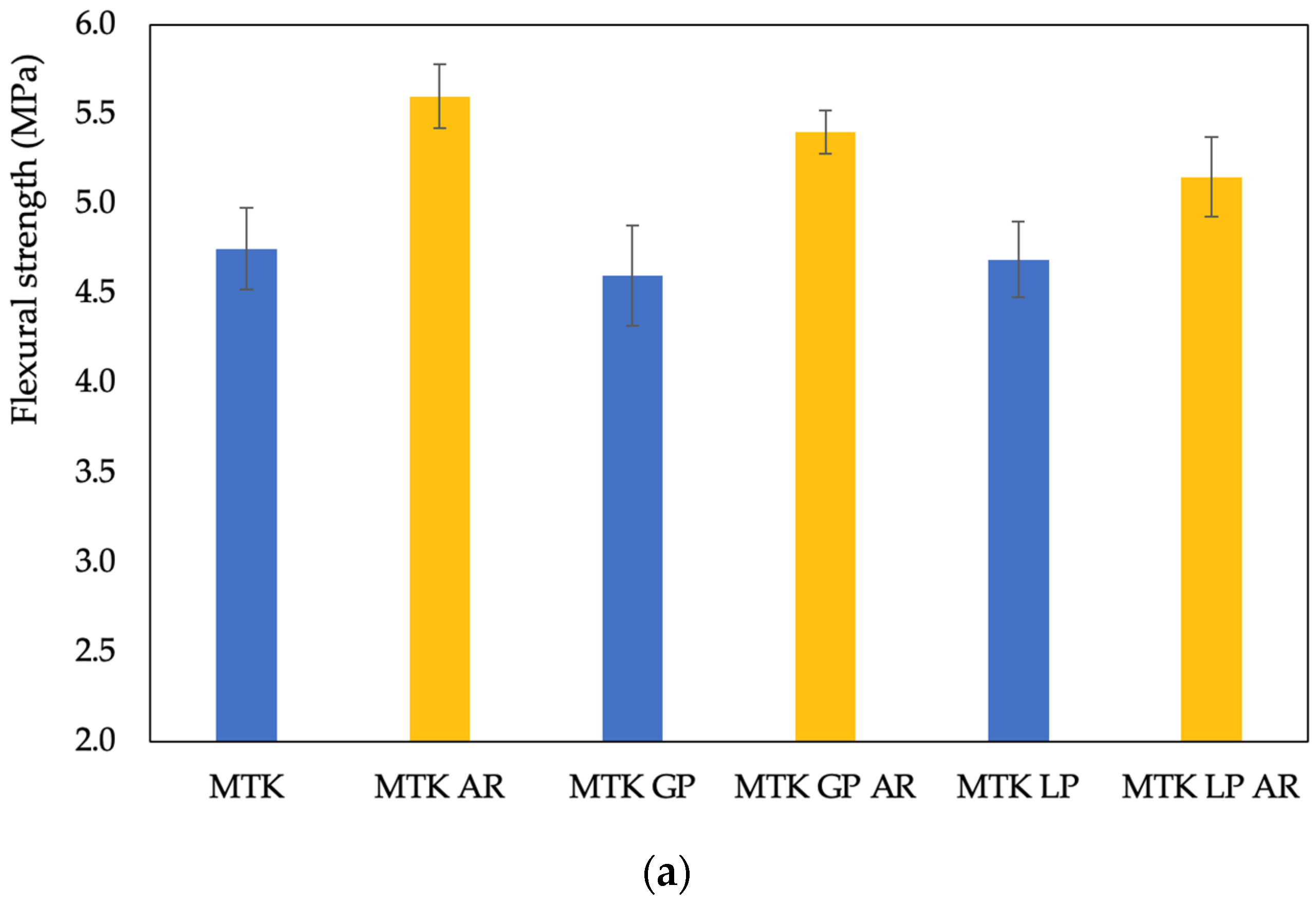
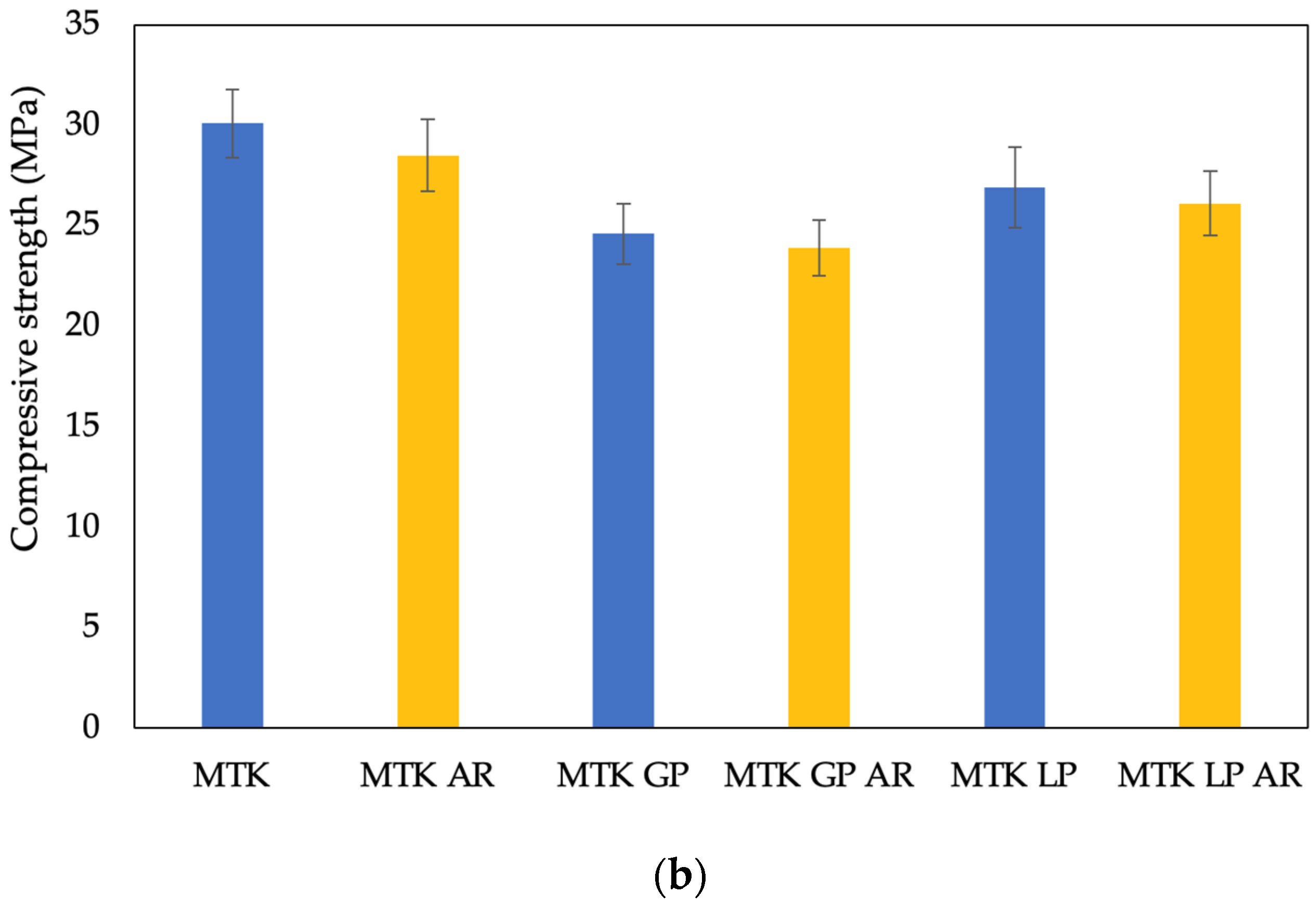
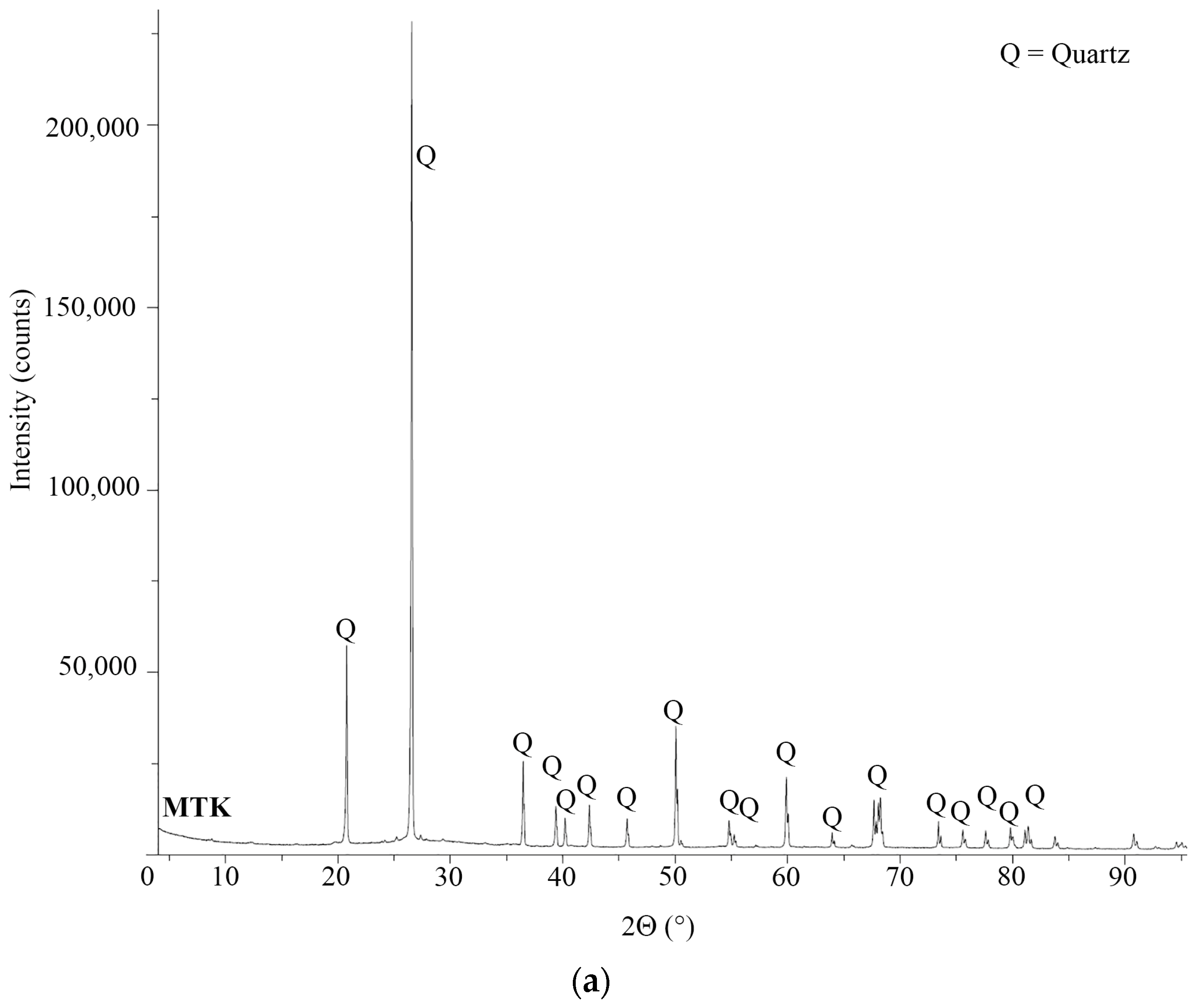

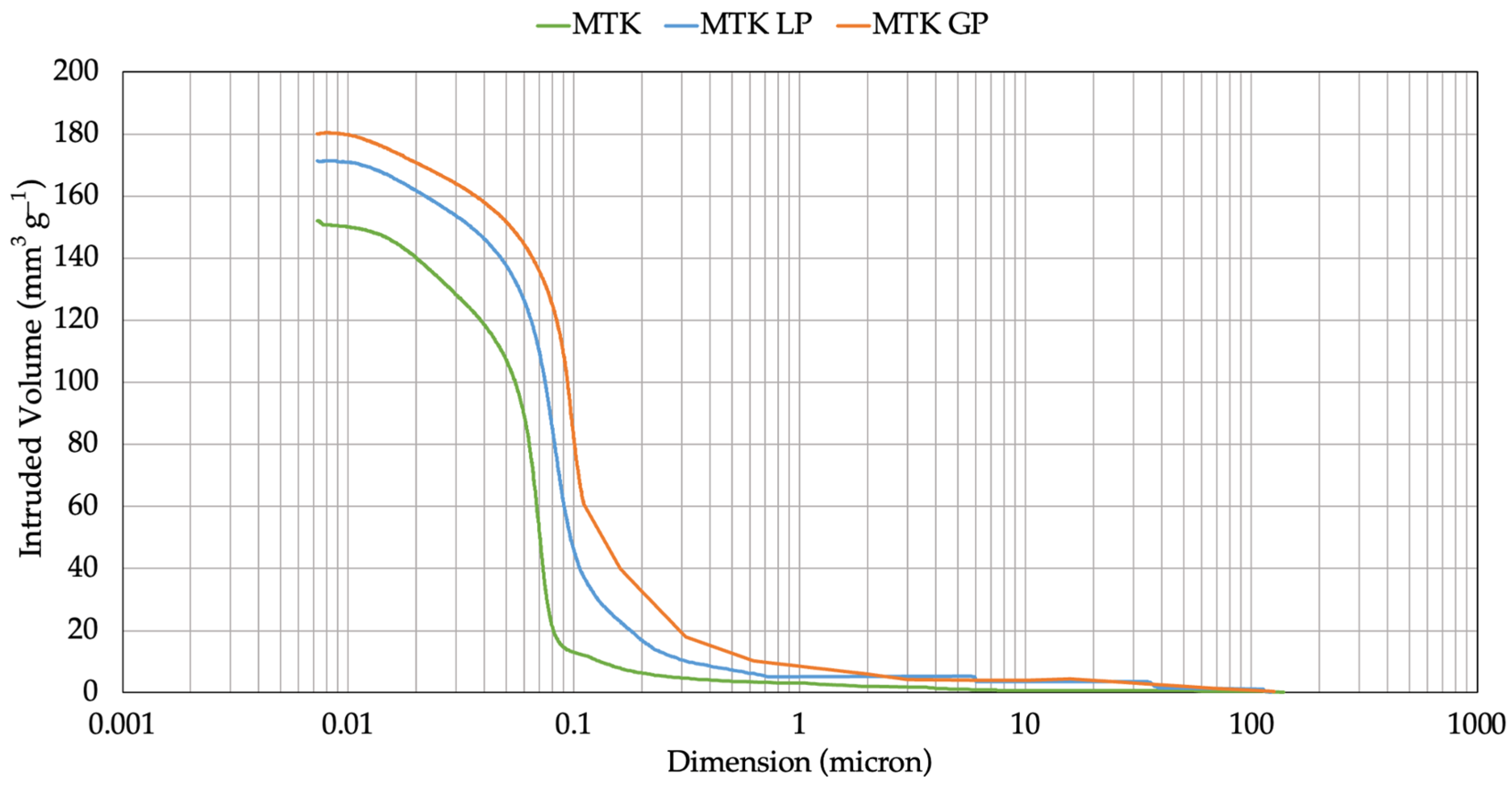


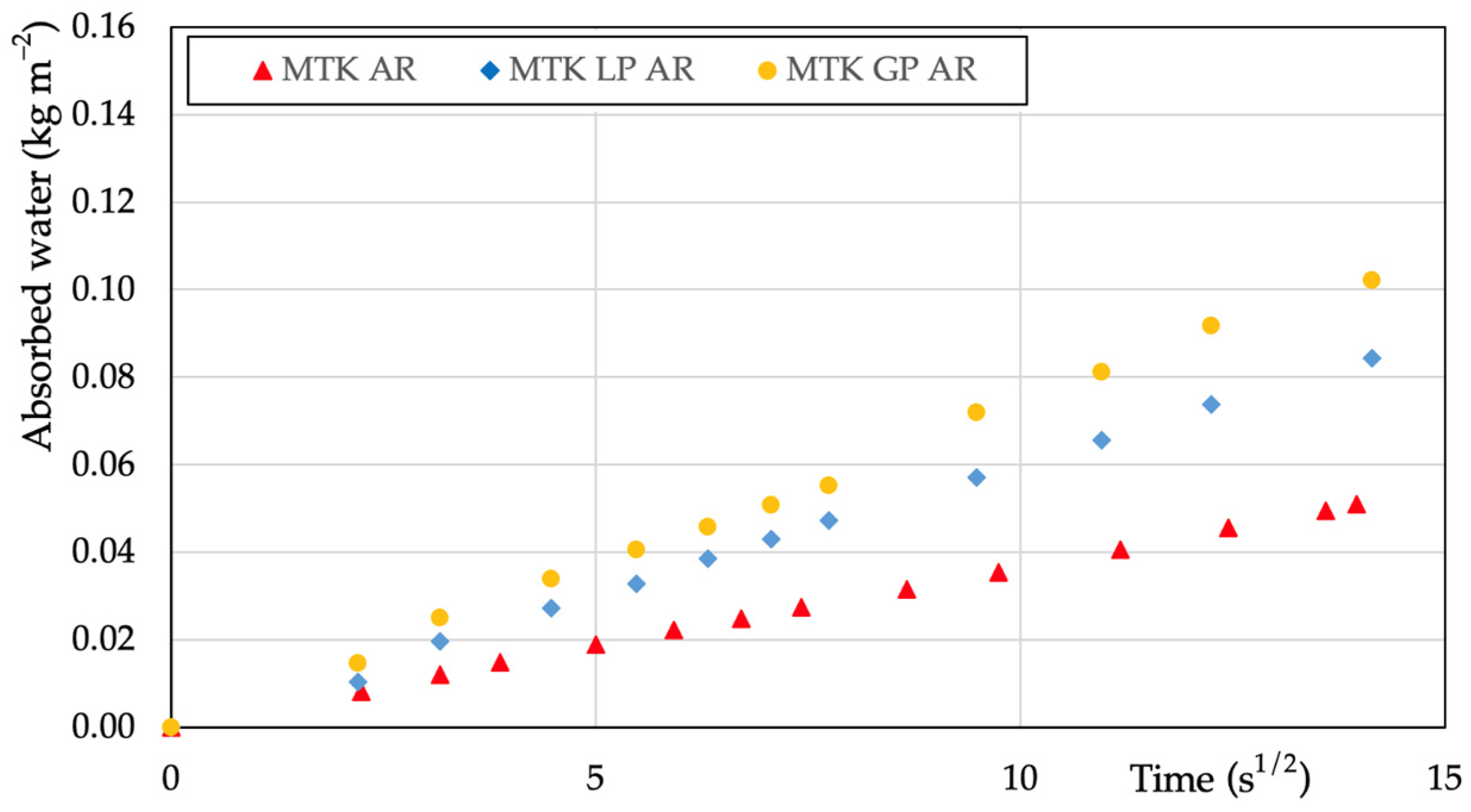
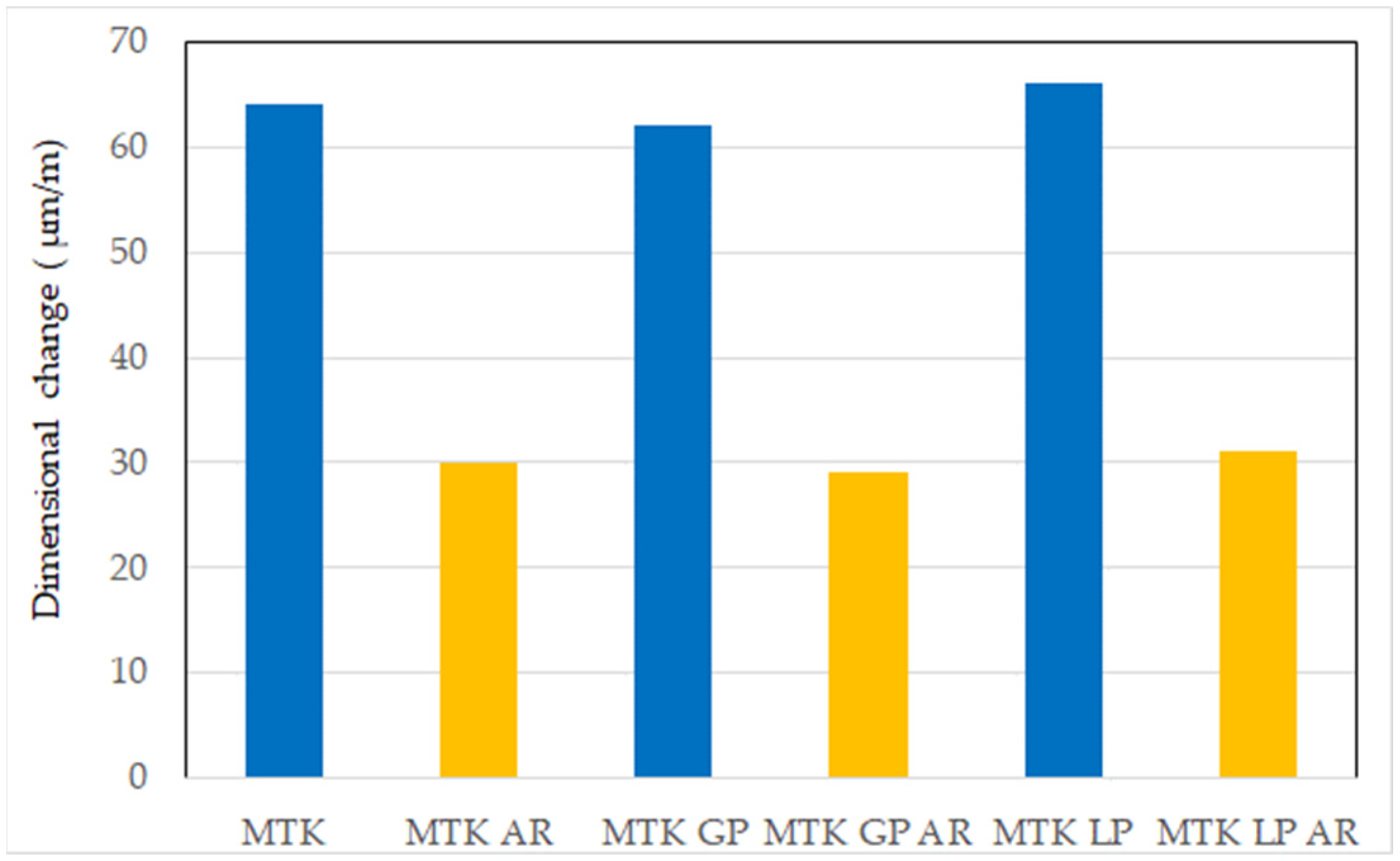
| Oxide | SiO2 | Al2O3 | CaO | MgO | TiO2 | K2O | Na2O | LOI |
|---|---|---|---|---|---|---|---|---|
| MTK | 72.0 | 22.1 | 0.4 | 0.1 | 1.0 | 0.3 | 0.04 | 2.4 |
| GP | 73.2 | 17.5 | 1.5 | 0.5 | 0.8 | 1.9 | 2.9 | 0.4 |
| LP | 53.5 | 15.2 | 11.7 | 1.1 | 0.1 | 3.9 | 4.7 | 6.2 |
| Sample | D10 | D50 | D90 | Density |
|---|---|---|---|---|
| MTK | 106 | 43 | 5 | 2.50 ± 0.02 |
| GP | 89 | 22 | 4 | 2.46 ± 0.01 |
| LP | 20 | 5 | 2 | 2.43 ± 0.02 |
| Sample | MTK | GP | LP | Fibers |
|---|---|---|---|---|
| MTK | 100 | 0 | 0 | 0 |
| MTK AR | 100 | 0 | 0 | 3 |
| MTK GP | 85 | 15 | 0 | 0 |
| MTK GP AR | 85 | 15 | 0 | 3 |
| MTK LP | 85 | 0 | 15 | 0 |
| MTK LP AR | 85 | 0 | 15 | 3 |
| Sample | Density (g/cm3) | dm (mm) | C (%) |
|---|---|---|---|
| MTK | 2.01 ± 0.03 | 194 ± 8 | 94 |
| MTK AR | 2.00 ± 0.06 | 183 ± 10 | 83 |
| MTK GP | 1.97 ± 0.05 | 202 ± 6 | 102 |
| MTK GP AR | 1.95 ± 0.07 | 190 ± 9 | 90 |
| MTK LP | 1.98 ± 0.05 | 179 ± 7 | 79 |
| MTK LP AR | 1.97 ± 0.06 | 168 ± 9 | 68 |
| Binder | No Fibers | Fibers |
|---|---|---|
| MTK | 4.2 × 10−3 | 3.6 × 10−3 |
| MTK GP | 10.3 × 10−3 | 7.7 × 10−3 |
| MTK LP | 6.3 × 10−3 | 6.0 × 10−3 |
Disclaimer/Publisher’s Note: The statements, opinions and data contained in all publications are solely those of the individual author(s) and contributor(s) and not of MDPI and/or the editor(s). MDPI and/or the editor(s) disclaim responsibility for any injury to people or property resulting from any ideas, methods, instructions or products referred to in the content. |
© 2024 by the authors. Licensee MDPI, Basel, Switzerland. This article is an open access article distributed under the terms and conditions of the Creative Commons Attribution (CC BY) license (https://creativecommons.org/licenses/by/4.0/).
Share and Cite
Manzi, S.; Molari, L.; Bignozzi, M.C.; Masi, G.; Saccani, A. Geopolymeric Composites Containing Industrial Waste Reinforced with Arundo donax Fibers. Buildings 2024, 14, 1191. https://doi.org/10.3390/buildings14051191
Manzi S, Molari L, Bignozzi MC, Masi G, Saccani A. Geopolymeric Composites Containing Industrial Waste Reinforced with Arundo donax Fibers. Buildings. 2024; 14(5):1191. https://doi.org/10.3390/buildings14051191
Chicago/Turabian StyleManzi, Stefania, Luisa Molari, Maria Chiara Bignozzi, Giulia Masi, and Andrea Saccani. 2024. "Geopolymeric Composites Containing Industrial Waste Reinforced with Arundo donax Fibers" Buildings 14, no. 5: 1191. https://doi.org/10.3390/buildings14051191





